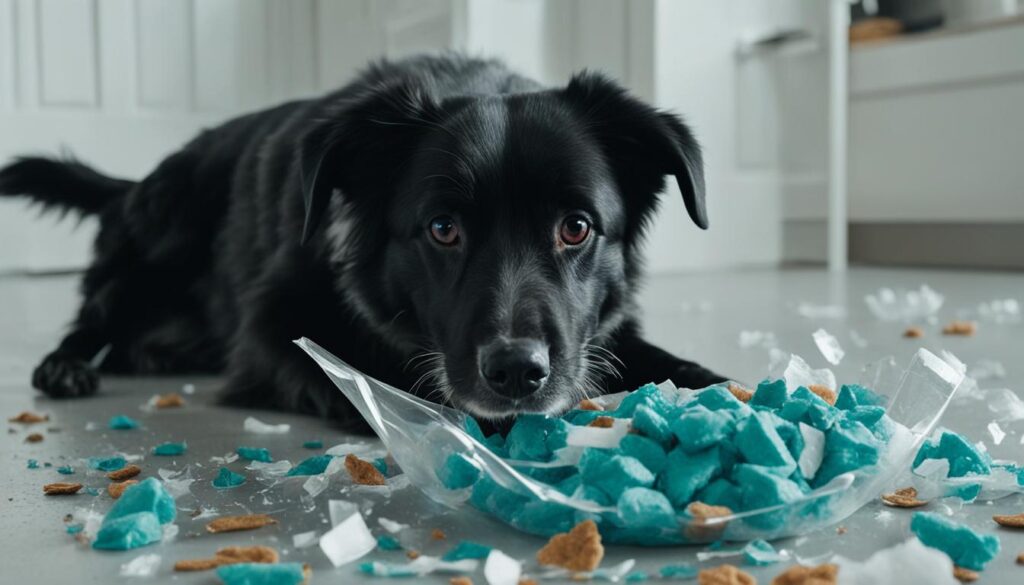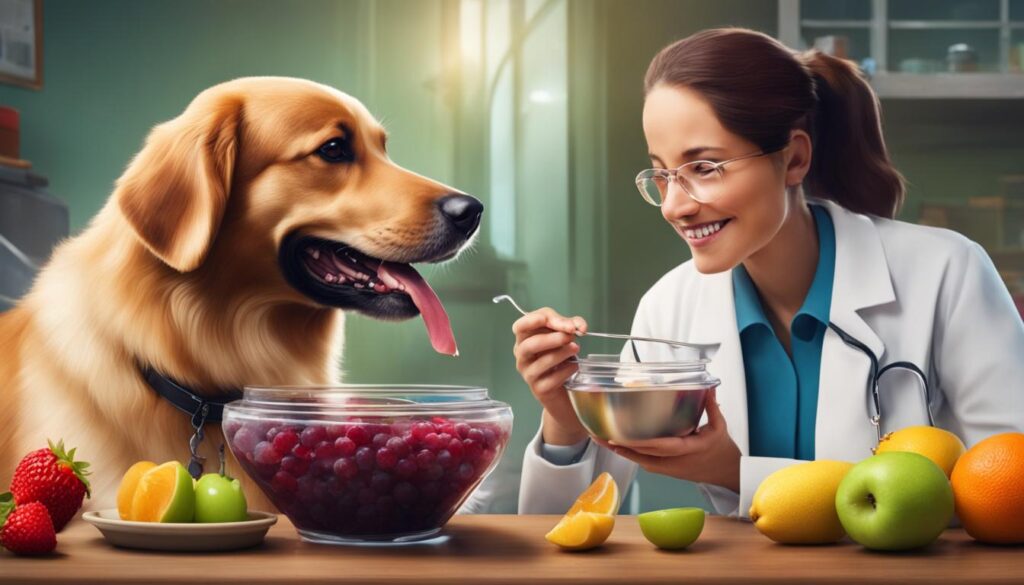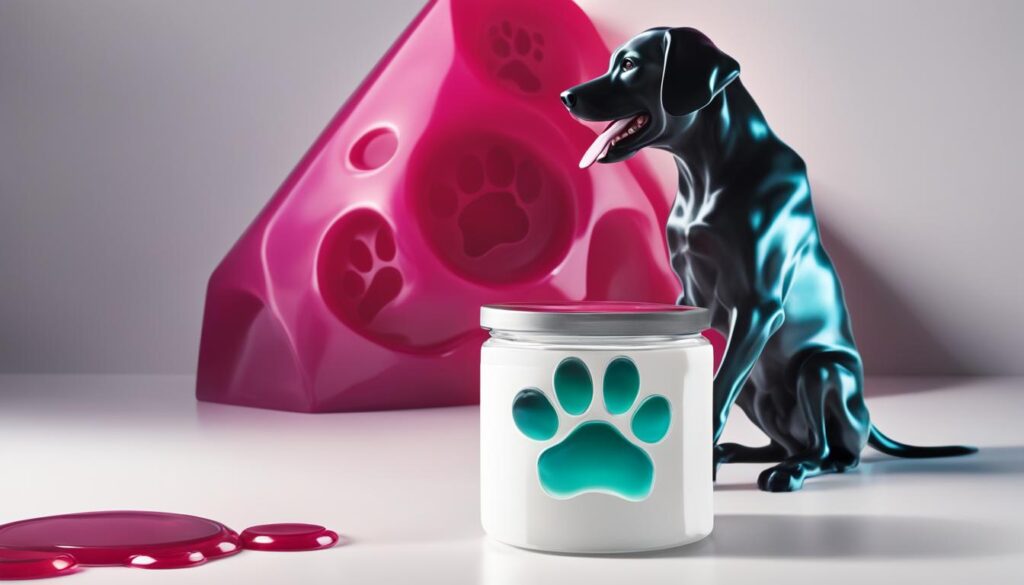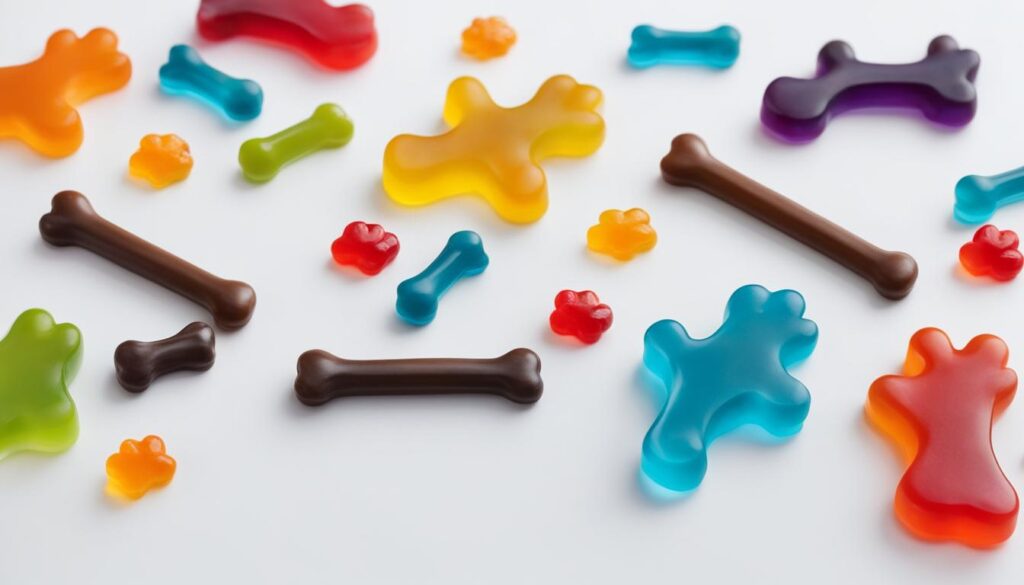Jelly is a popular sweet treat enjoyed by many humans, but can our canine companions partake in this fruity delight? As a responsible pet owner, it’s important to understand what foods are safe for our dogs to consume. In this article, we’ll explore the topic of dogs and jelly, examining whether it is safe for them to eat and the potential risks involved.
Key Takeaways:
- Jelly is not suitable for dogs due to its high sugar content and potential risks.
- Some sugar-free jellies may contain harmful ingredients that are toxic to dogs.
- Consult with a veterinarian if your dog has consumed jelly to ensure their safety.
- Feeding dogs actual fruits instead of jelly is a safer alternative.
- Homemade dog-safe jelly or specially formulated jelly for dogs can be considered in moderation.
Why Is Jelly Bad For Dogs?
Jelly, like jam, contains high amounts of sugar, which is not good for dogs. The fruit used to make the jelly can also impact its safety for dogs. Grapes, for example, are toxic to dogs. While jelly may have less of a reaction if it contains the juice of a toxic fruit, the sugar content can still cause health issues like diabetes, obesity, and heart problems in dogs.
What Should I Do If My Dog Ate Jelly?

If your dog has consumed jelly, it’s crucial to take immediate action to ensure their safety. The steps you take will depend on the type of jelly they consumed and its ingredients.
If the jelly contains real sugar, monitor your dog closely for any signs of distress or discomfort. While a small amount of sugar may not cause immediate harm, excessive consumption can lead to an array of health issues, including obesity, diabetes, and dental problems.
On the other hand, if the jelly contains a sugar substitute like xylitol, it is a medical emergency. Xylitol is highly toxic to dogs and can cause a rapid drop in blood sugar levels, leading to seizures, liver failure, and even death. Contact your veterinarian immediately if you suspect that your dog has ingested xylitol-containing jelly.
If the jelly contains the juice of a fruit that is toxic to dogs, such as grapes or raisins, it is vital to seek veterinary assistance. These fruits can cause kidney failure in dogs, and prompt action is necessary to mitigate any potential harm. Make sure to inform your vet about the specific fruit involved so they can provide appropriate guidance.
In any case, contacting a veterinarian is recommended whenever your dog consumes jelly. They can provide expert advice tailored to your dog’s specific situation and guide you on the best course of action to ensure your furry friend’s well-being.
Feeding Dogs Actual Fruit: A Safer Alternative
If you’re looking for a safer alternative to jelly, consider feeding your dog the actual fruit instead. While some fruits can be toxic, others, like apples or watermelon (without seeds or rind), can be a healthy and enjoyable treat for your dog. It’s essential to research and confirm which fruits are safe for dogs and offer them in moderation to avoid any adverse effects.
What is Jelly and Can Dogs Eat It?

Jelly can refer to different things depending on the country. In the United States and Canada, jelly usually refers to fruit preserves or spreads, which are not safe for dogs due to their high sugar content. In the United Kingdom and other parts of the world, jelly is a dessert made with fruit juice, gelatine, and sugar. Dogs can eat small amounts of homemade jelly made from dog-safe ingredients or specially formulated jelly made for dogs.
Let’s take a closer look at the composition of jelly in different countries and understand why some types are safe for dogs while others are not.
Jelly Composition in Different Countries
In the United States and Canada, jelly typically consists of fruit preserves or spreads. These products are made by cooking fruit juice or crushed fruit with sugar and pectin, a natural thickening agent. The high sugar content in these jellies makes them unsuitable for dogs. Additionally, some fruit preserves may contain ingredients that could be harmful or toxic to dogs.
On the other hand, jelly in the United Kingdom and many other countries refers to a gelatin-based dessert. This type of jelly is made by dissolving gelatine in hot fruit juice, adding sugar for sweetness, and allowing it to set into a wobbly consistency. While this jelly contains sugar, the texture and composition make it a safer option for dogs compared to fruit preserves.
Fruit Preserves vs. Dessert Jelly
The main difference between fruit preserves and dessert jelly lies in their composition and purpose. Fruit preserves are primarily used as spreads or toppings for bread, toast, or pastries. They are made with a higher concentration of fruit, sugar, and pectin to create a thick and jam-like consistency.
Dessert jelly, on the other hand, is a wobbly and gelatinous sweet treat that is commonly served as a dessert. It is typically made with fruit juice, gelatine, and sugar. The gelatine gives it its unique texture, while the fruit juice provides the flavor.
Jelly Made Specifically for Dogs
Recognizing the popularity of jelly as a treat for pets, some manufacturers have introduced specially formulated jelly made specifically for dogs. These dog-friendly jellies are crafted with ingredients that are safe and beneficial for canine consumption.
Specially formulated dog jellies often eliminate or reduce sugar content and substitute it with natural sweeteners that are safe for dogs. They can also incorporate flavors that appeal to dogs’ taste preferences. These jellies may contain added nutrients or beneficial ingredients to cater to dogs’ health needs.
Jelly Composition Comparison
| Country/Type of Jelly | Main Ingredients | Sugar Content | Safe for Dogs |
|---|---|---|---|
| United States/Canada (Fruit Preserves) | Fruit, Sugar, Pectin | High | No |
| United Kingdom/Other Countries (Dessert Jelly) | Fruit Juice, Gelatine, Sugar | Moderate | Small Amounts |
| Specially Formulated Dog Jelly | Dog-safe Ingredients, Natural Sweeteners | Reduced/Sugar-free | Yes |
Can Dogs Eat Gelatine?

Gelatine is a common ingredient found in various foods and products, and many dog owners may wonder if it is safe for their furry companions to consume. Let’s explore whether dogs can eat gelatine and what factors to consider.
Plain Gelatine for Dogs
Plain, unflavoured gelatine without any additives can be used in dog recipes and treats. It is a natural protein derived from collagen in animal tissues and bones. When used in moderation, gelatine can be a nutritious addition to a dog’s diet.
Gelatine-Based Products
While plain gelatine is generally safe for dogs, gelatine-based products made for human consumption may contain additives or ingredients that are not suitable for dogs. These products often include additional sugars, artificial flavors, or other potentially harmful substances. It is best to avoid feeding dogs gelatine-based foods intended for humans.
Digestive Sensitivity to Gelatine
Like humans, dogs can have varying degrees of sensitivity to certain ingredients, including gelatine. Some dogs may experience digestive issues such as bloating, gas, or diarrhea after consuming gelatine. If your dog shows any signs of discomfort or sensitivity, it is advisable to consult with a veterinarian.
Gelatine Capsules
Gelatine capsules are often used to encapsulate medications or supplements for both humans and animals. When prescribed by a veterinarian, gelatine capsules can be safely administered to dogs. It is important to follow the dosage instructions provided by the vet to ensure proper administration.
Overall, plain gelatine can be a beneficial addition to a dog’s diet when used appropriately. However, it is crucial to consider any digestive sensitivities and consult a veterinarian before introducing gelatine or gelatine-based products to your dog’s meals or treats.
Is Jelly Safe for Dogs?

The safety of jelly for dogs depends on its ingredients and preparation. While some types of jelly can be harmful to dogs, there are safe options available. Let’s explore the factors that contribute to the safety of jelly for dogs:
Sugar Content and Artificial Additives
High sugar content in jelly can pose health risks to dogs, including obesity, diabetes, and dental issues. It is essential to avoid giving dogs jelly with added sugars or artificial sweeteners like xylitol, which is highly toxic to dogs.
Homemade Dog Jelly
One way to ensure the safety of jelly for dogs is by making it at home with dog-safe ingredients. Homemade dog jelly can be made with natural fruit juices, gelatine, and water. By omitting added sugars and artificial additives, homemade dog jelly can be a healthier choice for your furry friend.
Fruit Content in Jelly
The fruit content in jelly should also be considered when evaluating its safety for dogs. Some fruits, such as grapes and raisins, are toxic to dogs and should never be included in jelly. When making homemade dog jelly, it’s important to use fruits that are safe for dogs, like apples, blueberries, or strawberries.
| Jelly Type | Safe for Dogs? |
|---|---|
| Commercial Jelly (high sugar, artificial additives) | No |
| Homemade Dog Jelly | Yes, if made with dog-safe ingredients |
| All-Natural Fruit Jelly | Depends on the fruits used |
Tip: When in doubt, consult with your veterinarian before offering jelly to your dog. They can provide specific guidance based on your dog’s health and dietary needs.
Keep in mind that jelly should always be given to dogs in moderation. It should not replace a balanced diet and should be treated as an occasional treat rather than a regular part of their meals.
By taking into account the sugar content, artificial additives, and fruit selection, you can ensure the safety of jelly when offering it to your canine companion.
Homemade Dog Jelly Options
When it comes to treating your furry friend to something sweet, homemade dog jelly can be a great option. By using dog-safe ingredients like fruit and vegetable purees or powders, and gelatine, you can create a tasty and safe jelly treat for your dog.
One option for making dog jelly is to use premade dog-friendly jelly mixes. These mixes are specifically formulated for dogs and can provide convenience without compromising on safety. However, it’s important to carefully check the ingredients to ensure there are no harmful additives that could be harmful to your dog’s health.
If you prefer a DIY approach, you can also make gummy dog treats using plain gelatine and dog-safe flavors. This allows you to have more control over the ingredients and customize the treats according to your dog’s preferences.
Whichever method you choose, homemade dog jelly can be a fun and nutritious way to treat your four-legged friend while ensuring their safety.
Premade Dog-Friendly Flavored Jelly Mix

If you’re a dog parent looking for a convenient and safe way to treat your furry friend, premade dog-friendly flavored jelly mixes are a great option. These mixes are specially formulated for dogs, ensuring that they get a delicious and enjoyable treat without compromising their health. The convenience of premade options allows you to quickly and easily prepare a special treat for your dog without the need for extensive preparation.
One of the key advantages of these premade mixes is that they use natural ingredients. This means that you can feel confident knowing that your dog is consuming safe and wholesome ingredients. However, it’s always essential to be an informed pet parent and check the ingredients list for any potential harmful additives. By doing so, you can ensure that the premade jelly mix you choose aligns with your dog’s dietary needs and preferences.
Here’s an example of the ingredients you might find in a premade dog-friendly jelly mix:
| Ingredients | Benefits |
|---|---|
| Natural fruit purees | Provide vitamins and minerals |
| Gelatine | Creates a jelly-like texture |
| Water | Hydrates your dog |
| Stevia (natural sweetener) | Offers a hint of sweetness without added sugar |
By opting for a premade mix, you can have peace of mind knowing that your dog is enjoying a treat made specifically for them. These mixes offer a balance between convenience and safety, allowing you to provide your dog with a flavorful and enjoyable jelly treat with minimal effort.
Why Choose Premade Dog-Friendly Flavored Jelly Mix?
There are several reasons why premade dog-friendly flavored jelly mixes have become a popular choice among dog owners:
- Convenience: Save time and effort by using premade mixes instead of starting from scratch.
- Specifically formulated for dogs: These mixes are designed to meet your dog’s dietary needs and taste preferences.
- Natural ingredients: You can feel confident knowing that your dog is consuming safe and wholesome ingredients.
- No added sugars: Many premade mixes use natural sweeteners or are sugar-free, making them a healthier choice.
- Easy preparation: Simply follow the instructions on the packaging to create a tasty jelly treat for your dog.
Next time you want to surprise your furry friend with a delightful treat, consider trying out a premade dog-friendly flavored jelly mix. Your dog will thank you for the delicious and safe indulgence!
DIY Gummy Dog Treats

Gummy dog treats are a fun and creative way to spoil your furry friend while ensuring they get a healthy and nutritious snack. Making homemade gummy treats for dogs is easy and allows you to customize the ingredients to suit their tastes and dietary needs.
Homemade Dog Jelly Recipes
To create delicious homemade dog jelly, start with a base of plain gelatine. Gelatine is safe for dogs and provides a chewy texture that they love. You can then add various ingredients to customize the flavor and nutritional content of the treats.
Here’s a simple recipe to get you started:
- Dissolve 1 tablespoon of plain gelatine in 1 cup of warm water.
- Add in your dog’s favorite fruit or vegetable puree. Some popular options include pumpkin, sweet potato, and banana.
- Mix well until all the ingredients are combined.
- Pour the mixture into silicone molds or a baking dish lined with parchment paper.
- Place the molds or dish in the refrigerator and let the jelly set for a few hours or overnight.
- Once set, remove the gummy treats from the molds or cut them into bite-sized pieces if using a baking dish.
Remember to consult with your veterinarian about the specific quantities and ingredients that are suitable for your dog’s diet and health needs.
Customization of Dog Treats
The best part about making DIY gummy dog treats is that you can customize them according to your dog’s preferences and dietary requirements. You can experiment with different fruit and vegetable combinations to provide a variety of flavors and nutrients.
Here are some ingredient ideas to consider:
- Blueberries: Packed with antioxidants and high in fiber.
- Carrots: Great for dental health and a rich source of vitamins.
- Apples: Provide vitamins and a natural sweetness.
- Spinach: Rich in iron and other essential nutrients.
Feel free to get creative and come up with your own unique combinations based on your dog’s taste preferences and nutritional needs.
Remember, while making homemade gummy dog treats is a fun and rewarding activity, it’s important to feed them to your dog in moderation. Treats should never replace a balanced and complete diet provided by a high-quality dog food.
| Treat | Ingredients | Benefits |
|---|---|---|
| Fruity Delight | Strawberries, watermelon, and plain gelatine | High in antioxidants and hydrating |
| Pumpkin Patch | Pumpkin puree, cinnamon, and plain gelatine | Supports a healthy digestive system and adds a touch of warmth |
| Green Machine | Kale, green apple, and plain gelatine | Rich in vitamins and minerals for overall health |
Remember to introduce new ingredients gradually into your dog’s diet and monitor for any adverse reactions. If you notice any unusual symptoms, consult with your veterinarian.
Wrapping Up
In conclusion, it is not recommended to feed jelly to dogs due to its high sugar content and the potential presence of toxic additives like xylitol. Feeding dogs jelly can lead to various health issues, including diabetes, obesity, and heart problems. However, there are safer alternatives available for dog owners.
One option is to prepare homemade jelly using dog-safe ingredients and without adding any sugars or artificial additives. By using natural fruit or vegetable purees, gelatine, and other dog-friendly ingredients, dog owners can ensure that the jelly is safer for their furry friends.
Another option is to choose premade jelly mixes that are specifically designed for dogs. These mixes use natural ingredients and eliminate any harmful additives that could be found in regular jellies meant for human consumption. It is essential to carefully check the ingredients list before purchasing premade jelly mixes to guarantee the safety of the product.
If a dog accidentally consumes jelly or shows any signs of distress, it is crucial to consult a veterinarian immediately. They can provide the necessary guidance and recommend appropriate measures to mitigate any potential harm caused by the jelly ingestion.
Overall, while dogs should not eat regular jelly, homemade jelly made with dog-safe ingredients and premade dog-friendly jelly mixes can be safer alternatives. It is crucial to prioritize the health and well-being of our furry companions by making informed choices about their diet and consulting professionals whenever necessary.
FAQ
Can dogs eat jelly?
No, dogs should not eat jelly. Jelly is mostly sugar, which can be harmful to dogs in large amounts. Some sugar-free jellies may also be toxic to dogs. It is best to keep jelly away from dogs and consult a veterinarian if they have consumed jelly.
Why is jelly bad for dogs?
Jelly contains high amounts of sugar, which is not good for dogs. The fruit used to make the jelly can also impact its safety for dogs. Grapes, for example, are toxic to dogs. While jelly may have less of a reaction if it contains the juice of a toxic fruit, the sugar content can still cause health issues like diabetes, obesity, and heart problems in dogs.
What should I do if my dog ate jelly?
If a dog has eaten jelly, it is important to determine if it contains real sugar or a sugar substitute. Sugar substitutes like xylitol are extremely toxic to dogs and require immediate veterinary attention. If the jelly contains the juice of a fruit that is toxic to dogs, contacting a vet is also recommended. Feeding dogs the actual fruit is a safer alternative to jelly.
What is jelly and can dogs eat it?
Jelly can refer to different things depending on the country. In the United States and Canada, jelly usually refers to fruit preserves or spreads, which are not safe for dogs due to their high sugar content. In the United Kingdom and other parts of the world, jelly is a dessert made with fruit juice, gelatin, and sugar. Dogs can eat small amounts of homemade jelly made from dog-safe ingredients or specially formulated jelly made for dogs.
Can dogs eat gelatin?
Plain, unflavored gelatin without additives can be used in dog recipes and treats. Gelatin-based products for human consumption may contain unsuitable ingredients for dogs and should be avoided. Some dogs may have digestive sensitivities to gelatin, and gelatin capsules used for medications can be safe when administered as directed by a vet.
Is jelly safe for dogs?
The safety of jelly for dogs depends on its ingredients and preparation. Jelly with high sugar content, artificial additives, and xylitol should be avoided. Homemade jelly made with dog-safe ingredients and without added sugars or artificial additives can be safe for dogs in small quantities. The fruit content in jelly should also be considered, as some fruits are toxic to dogs.
What are some homemade dog jelly options?
Homemade dog jelly can be made using dog-safe ingredients like fruit and vegetable purees or powders, and gelatin. Dog-specific jelly mixes are available for convenience, but it is important to check the ingredients for any harmful additives. DIY gummy dog treats can also be made using plain gelatin and dog-safe flavors.
Are there premade dog-friendly flavored jelly mixes?
Yes, premade dog-friendly flavored jelly mixes are available for dog parents who want to offer their dogs a safe and tasty treat without the need for extensive preparation. These mixes are specially formulated for dogs and use natural ingredients. However, it is important to check the ingredients list for any potential harmful additives.
Can I make DIY gummy dog treats?
Yes, homemade gummy dog treats can be made from scratch using dog-safe ingredients and plain gelatin. Recipes can be customized with different fruit or vegetable purees to suit a dog’s preferences. These treats can be a healthy and nutritious option for dogs.






